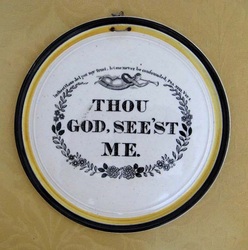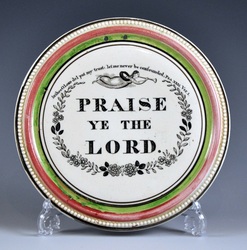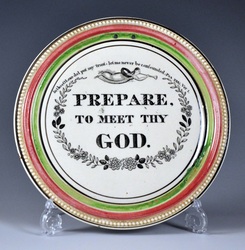|
2/20/2011 0 Comments Plaques attributed to NewbottleIn my February 13th blog post, I talked about Scott 'commissioning' two sets of transfer plates (Prepare... Thou... & Praise...) – one with 'In the O Lord...' and the other with 'In thee O Lord' in the verse above the trumpeting angel. The word 'the' appears on small fine plaques of the 1830s, on which the Wesley and Clarke transfers associated with Scott also appear. The word 'thee', however, doesn't appear on Scott-attributed items until c1845. There's one scenario I hadn't considered. What if Scott commissioned only one set of transfer plates in the 1830s (with the word 'the'), but at the same time, the engraver made another set of copper plates (with the word 'thee') for another pottery? Then, at a later date, because of the popularity of the verses, Scott somehow managed to acquire this second set. So is there any evidence the 'thee' transfers were used before c1845? Stephen Duckworth drew my attention to the 'Praise ye the lord' plaque in the V&A on-line collection (see below right). At first glance it looks similar to the Cornfoot, Colville & Co plaques of the late 1820s, but the pottery never made plaques with that verse. The plaques below are, in fact, from the 'thee' transfer set, which would later be used by Scott. Interestingly, all three plaques have faults of execution, with thumb prints and bleeding to the glaze of the black outer border. The V&A attributes their 'Praise' plaque to 'Newbottle'. To me, until now, this seemed fanciful, as the plaque bears no maker's mark. But this weekend I reread Baker's 'Newbottle Potteries' chapter and found the following (p44): "The Victoria and Albert Museum have in their collections the following examples given by Mr W H Fairbairns in 1905: Vase, with lid, decorated with painted design of trees and cottages in pink lustre; circular plaque with religious motto, "Praise ye the Lord", and a broad band of copper lustre on rim; glazed, moulded earthenware figure of a goat; a bust of John Wesley; a child's plate with daisy pattern embossed rim and central transfer of a girl holding a bird; a set of three children's plates with embossed rims with mottoes, each with a differing transfer design and verse, and general title, 'Flowers That Never Fade'. The attribution of this wide range of pottery to Newbottle has been questioned, despite the fact the donor was a descendent of the owners of the 'High' Pottery and presumably had knowledge of its products. The children's pottery plates in particular would normally be regarded as Staffordshire products, yet a sherd of wasted plate uncovered from Newbottle in 1980 showing a fragment of 'Flowers that Never Fade is evidence that such pottery was, in fact, made in Newbottle and probably at other Wearside potteries." It seems that Baker made an error in describing the border of the plaque as having a 'broad band of copper lustre'. But remember, in 1984 when he revised and edited his book, the descriptions couldn't be checked through a 10-minute internet search! Click here to see the items that come up if you search the V&A catalogue for Newbottle. You'll note they are all gifts of W H Fairbairns. So how did the transfer plates arrive at Scott's Southwick Pottery? Anthony Scott managed the 'High' Newbottle Pottery until 1788, when he and his father set up their pottery in Southwick. After that Robert Fairbairns took over the management of the 'High' Pottery, and continued until John Broddick acquired it sometime between 1841 and 1851 (Baker). This change of ownership, therefore, seems the most likely reason for the transfer plates moving to Scott. The date range fits perfectly. It perhaps makes sense that with the Newbottle link, Fairbairns should sell the transfer plates to Anthony Scott (who died in 1847). So are there any other recorded plaques with these transfers that fit the Newbottle era (c1830–c1845)? The three plaques below are very fine, and could belong to the Newbottle period of production. Below is a comparison of the two 'prepare' plaques above, with the 'prepare' attributed to Scott c1845 (right column of photos). The centre, Newbottle-attributed plaque, and the Scott-attributed plaque are certainly from the same transfer plate. The plaque on the left is very slightly different. As noted in my January 30th blog post, the leaves on the left of the sprig are more heavily shaded on the left side (see bottom row of photos). This variation occurs amongst the plaques attributed to Scott, and I've put it down to re-engraving of the transfer plate over time. Interestingly though, the plaques with shading on the left of the leaves tend to be later, like the brown-bordered plaques, c1850s onwards. And yet, if I'd had to guess, I would have said the circular plaque was older. So either these red and green circular plaques continued to be made later than was previously supposed, or there's a third variation of this transfer plate.
0 Comments
Leave a Reply. |
AuthorStephen Smith lives in London, and is always happy to hear from other collectors. If you have an interesting collection of plaques, and are based in the UK, he will photograph them for you. Free advice given regarding selling and dispersal of a collection, or to those wishing to start one. Just get in touch... Archives
February 2022
AcknowledgementsThis website is indebted to collectors, dealers and enthusiasts who have shared their knowledge or photos. In particular: Ian Holmes, Stephen Duckworth, Dick Henrywood, Norman Lowe, Keith Lovell, Donald H Ryan, Harold Crowder, Jack and Joyce Cockerill, Myrna Schkolne, Elinor Penna, Ian Sharp, Shauna Gregg at the Sunderland Museum, Keith Bell, Martyn Edgell, and Liz Denton.
|

















